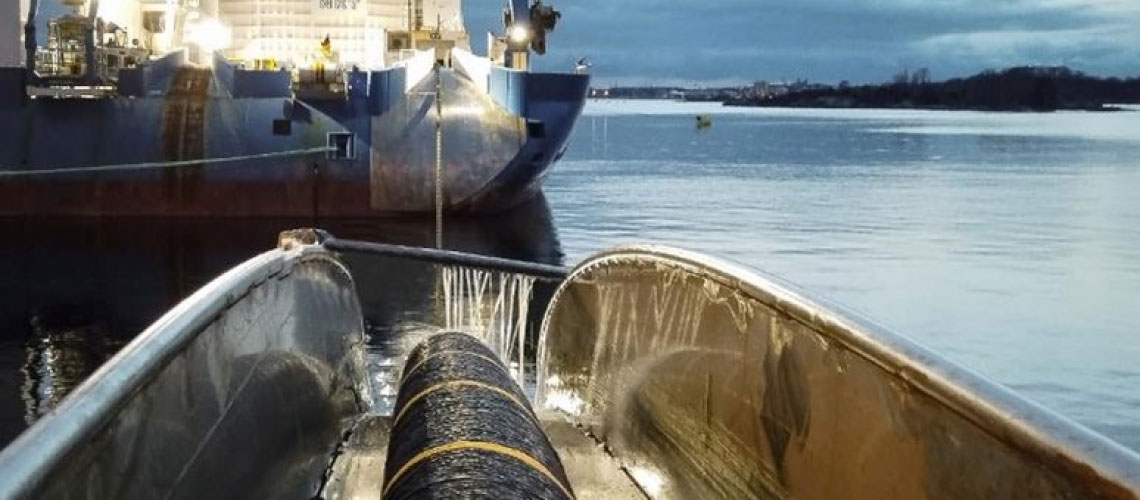
Published
- Sustainability
- Guarantees
Swedish cables connect a greener future
The energy transition has triggered a boom in demand for power cables that can transport the green energy harvested by solar and wind farms over long distances. The drive to renew and connect national grids further fuel demand at cable maker NKT, with major export production in Sweden and guarantees from EKN.
Some industries benefit more than others from the redrawing of energy maps in the wake of the energy transition. High-voltage DC (HVDC) cables that link offshore windfarms with national grids is one example. NKT, listed in Denmark and with production in Karlskrona, Sweden and other sites, is one of the world’s leading suppliers of such cables. The soaring demand has prompted investments in new production and installation facilities and the company expects EBITDA to double within three years.
Sweden and the other Nordic countries enjoy the advantage of being early adopters of the shift towards increased sustainability, businesses as well as governments and citizens. Pär Granlund, Senior Underwriter at EKN says: “Nordic suppliers have been able to benefit from a strong domestic demand for greentech, from solar and wind to EVs. Supporting exports from NKT and Hitachi Energy is perfectly aligned with the ambition of the Swedish export credit system to actively support the energy transition.”
The Swedish government has assigned the country’s export credit system the task of contributing to the climate transition. Financiers benefit from new guarantees from government agencies EKN and Riksgälden (The National Debt Office), backed by Sweden’s AAA rating, as well as the green loans issued by state-owned Svensk Exportkredit (SEK).
“Offshore wind can’t happen without high-voltage cables”, says Louise Westh Naldal, Head of Group Communications at NKT. “The strong demand for cables in general is driven by the transition to renewable energy where ambitions are ramped up significantly across Europe, especially in offshore wind but also in onshore wind and solar.”
Green Guarantees cover 100 percent
EKN’s Green Export Credit Guarantee lets exporters and banks insure up to 100 per cent of the value of a transaction to protect themselves from the risk of non-payment. EKN’s standard export credit guarantees normally offer up to 95 percent risk cover.
Renewable energy sources require a significant cable infrastructure. Demand for cables is also driven by interconnectors, where countries connect their national grids to be able to exchange the energy harvested. The invasion of Ukraine has prompted many countries to rethink their energy strategy and seek to replace Russian gas with other alternatives.
One of the world’s biggest offshore wind zones, Hornsea in the North Sea, is about to embark on its third phase, Hornsea 3. NKT will deliver the HVDC cables with a contract value of approximately EUR 500 million, supported by Counter Guarantees from EKN for an advance payment and performance bond. Hornsea 3 will boost the total capacity to 5GW, enough to power up to 5 million UK homes.
To a layman, power cables may seem like a mature technology, but the skills required to construct cables that can utilise and transport the large amounts of energy produced by megafarms across the bottom of the sea is evolving. Higher voltage levels are required and in recent years, NKT was the first power cable manufacturer to introduce 525 kV HVDC power cable systems with XLPE (cross-linked polyethylene) insulation, which is a key element in developing a DC grid that can utilise renewable energy generation more efficiently. It will be applied in the German corridor projects and connect future offshore windfarms to shore in the Netherlands, to name a few examples.
Incidentally, the converter stations in the Hornsea project are also produced in Sweden by Hitachi Energy. They are necessary to convert the DC current to AC before it reaches the end users. But why bother to use DC at all? Because the power loss from transporting AC over longer distances is significantly higher than for DC. Ask any electrical engineer.
Lighting up New York City
Another project where NKT cooperates with EKN is for a cable project to the Champlain Hudson Power Express transmission line from the Québec area in Canada to New York City. Developed in anticipation of New York state’s transition from fossil fuel to clean energy, the cable will power New Yorkers with clean, renewable hydropower. The state’s new climate legislation requires that New York is powered by 70 percent renewable energy by 2030. The CHPE is expected to be fully operational in spring of 2026, delivering 1,250 MW of renewable power directly into the New York Metro area.
As for funding of the infrastructure required for the energy transition it has become easier over the past few years. “Industry players don’t seem to consider funding as the main barrier, as much as the permit process and the time it takes to obtain government approvals of renewable energy projects”, says Naldal.
Fixing the global warming is a top priority of the world, and it shows. EU aims to be climate neutral in 2050 and ambitious plans such as the Ostend declaration targeting 300 GW renewable wind power by then will ensure the transition.
